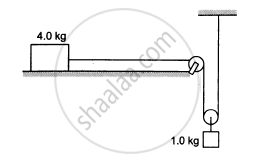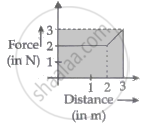Advertisements
Advertisements
प्रश्न
Consider the situation shown in the following figure. The system is released from rest and the block of mass 1 kg is found to have a speed 0⋅3 m/s after it has descended a distance of 1 m. Find the coefficient of kinetic friction between the block and the table.

उत्तर
\[\text{Given}, \]
\[ \text{m}_1 = 4 \text{ kg, m}_2 = 1 \text{kg } , \]
\[ \text{v}_2 = 0 . 3 \text{ m/s}\]
\[ \text{v}_1 = 2 \times 0 . 3 = 0 . 6 \text{ m/s}\]
\[\left( \text{ v}_1 = 2 \text{ v}_2 \text{ in this system } \right)\]
\[\text{ Height descended by the 1 kg block, h = 1 m } \]
\[\text{ Distance travelled by the 4 kg block } , \]
\[\text{ s } = 2 \times 1 = 2 \text{ m }\]
\[\text{ Initially the system is at rest . So, u }= 0\]
\[\text{ Applying work energy theoremwhich says that } \]
\[\text{ change in K . E . = Work done } \left( \text{ for the system } \right)\]
\[\left( \frac{1}{2} \right) \text{m}_1 \nu_1^2 + \left( \frac{1}{2} \right) \text{m}_2 \nu_2^2 = \left( - \mu \text{ R } \right) \text{ s } + \text{m}_2 \text{gh}\]
\[\frac{1}{2} \times 4 \times \left( 0 . 36 \right) + \frac{1}{2} \times 1 \times \left( 0 . 09 \right) [\text{ As, R = 4g = 40 N} ]\]
\[ = - \mu 40 \times 2 + 1 \times 40 \times 1\]
\[ \Rightarrow 0 . 72 + 0 . 045 = - 80 \mu + 10\]
\[ \Rightarrow \mu = \frac{9 . 235}{80} = 0 . 12\]
So, the coefficient of kinetic friction between the block and the table is 0.12 .
APPEARS IN
संबंधित प्रश्न
A ball is given a speed v on a rough horizontal surface. The ball travels through a distance l on the surface and stops. what are the initial and final kinetic energies of the ball?
Consider the situation of the previous question from a frame moving with a speed v0 parallel to the initial velocity of the block. (a) What are the initial and final kinetic energies? (b) What is the work done by the kinetic friction?
The US athlete Florence Griffith-Joyner won the 100 m sprint gold medal at Seoul Olympics in 1988, setting a new Olympic record of 10⋅54 s. Assume that she achieved her maximum speed in a very short time and then ran the race with that speed till she crossed the line. Take her mass to be 50 kg. What power Griffith-Joyner had to exert to maintain uniform speed?
A water pump lifts water from 10 m below the ground. Water is pumped at a rate of 30 kg/minute with negligible velocity. Calculate the minimum horsepower that the engine should have to do this.
An unruly demonstrator lifts a stone of mass 200 g from the ground and throws it at his opponent. At the time of projection, the stone is 150 cm above the ground and has a speed of 3 m/s. Calculate the work done by the demonstrator during the process. If it takes one second for the demonstrator to lift the stone and throw it, what horsepower does he use?
In a factory, 2000 kg of metal needs to be lifted by an engine through a distance of 12 m in 1 minute. Find the minimum horsepower of the engine to be used.
A block of mass 5 kg is suspended from the end of a vertical spring which is stretched by 10 cm under the load of the block. The block is given a sharp impulse from below, so that it acquires an upward speed of 2 m/s. How high will it rise? Take g = 10 m/s2.
A block of mass 250 g is kept on a vertical spring of spring constant 100 N/m fixed from below. The spring is now compressed 10 cm shorter than its natural length and the system is released from this position. How high does the block rise ? Take g = 10 m/s2.
A simple pendulum consists of a 50 cm long string connected to a 100 g ball. The ball is pulled aside so that the string makes an angle of 37° with the vertical and is then released. Find the tension in the string when the bob is at its lowest position.
The bob of a stationary pendulum is given a sharp hit to impart it a horizontal speed of \[\sqrt{3 gl}\] . Find the angle rotated by the string before it becomes slack.
A particle slides on the surface of a fixed smooth sphere starting from the topmost point. Find the angle rotated by the radius through the particle, when it leaves contact with the sphere.
A particle of mass m is kept on the top of a smooth sphere of radius R. It is given a sharp impulse which imparts it a horizontal speed ν. (a) Find the normal force between the sphere and the particle just after the impulse. (b) What should be the minimum value of ν for which the particle does not slip on the sphere? (c) Assuming the velocity ν to be half the minimum calculated in part, (b) find the angle made by the radius through the particle with the vertical when it leaves the sphere.
A smooth sphere of radius R is made to translate in a straight line with a constant acceleration a. A particle kept on the top of the sphere is released at zero velocity with respect to the sphere. Find the speed of the particle with respect to the sphere as a function of the angle θ it slides.
A man, of mass m, standing at the bottom of the staircase, of height L climbs it and stands at its top.
- Work done by all forces on man is equal to the rise in potential energy mgL.
- Work done by all forces on man is zero.
- Work done by the gravitational force on man is mgL.
- The reaction force from a step does not do work because the point of application of the force does not move while the force exists.
Give example of a situation in which an applied force does not result in a change in kinetic energy.
A rocket accelerates straight up by ejecting gas downwards. In a small time interval ∆t, it ejects a gas of mass ∆m at a relative speed u. Calculate KE of the entire system at t + ∆t and t and show that the device that ejects gas does work = `(1/2)∆m u^2` in this time interval (neglect gravity).
A particle moves in one dimension from rest under the influence of a force that varies with the distance travelled by the particle as shown in the figure. The kinetic energy of the particle after it has travelled 3 m is ______.

